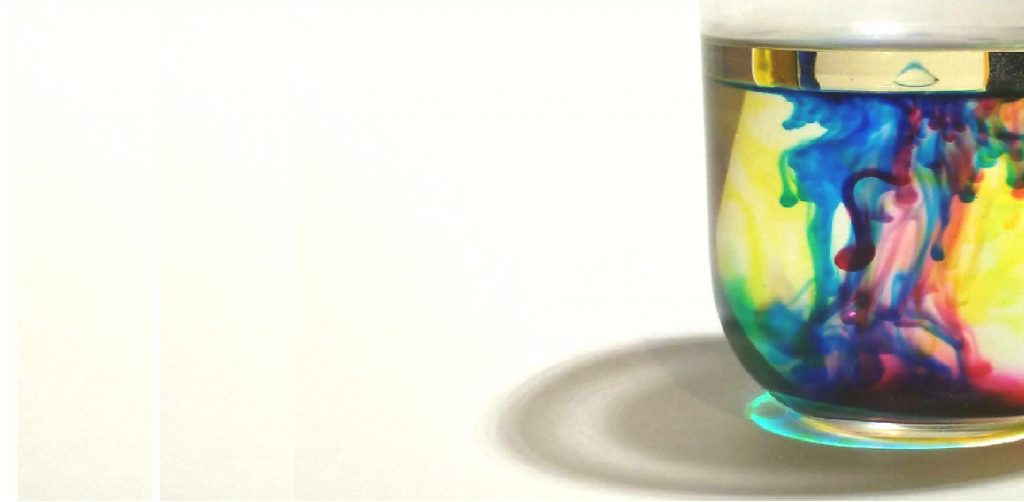Fireworks in a Jar experiment – 3 easy steps to try!
Fireworks in a Jar is one of our favourite demonstrations and is so easy to do.
The colours explode into the water and create a tumbling rainbow which is mesmerising to watch, the colourful columns change shape as they gracefully fall, and new colours are formed as the original ones mix together.
This activity is not just pretty to look at, it creates an opportunity for talking and teaching about immiscible liquids, gravity & diffusion, which all play a part in this colourful display.
Let us know how you get on and please share your pictures onto our Facebook page at Devon Science
OK, so here’s how to make your own Fireworks in a Jar, or scroll down for the full video.
You will need:
A clean glass jar, warm water, cooking oil or baby oil, food colouring, droppers or pipettes (or something which will help you add the colourings in droplets).
Method
1) Grab a clean glass and fill it to about ¾ full with water. A tall glass is better as the colour will have further to fall, making the display last longer.
2) Pour a thin layer (about 3-4 mm) of oil (we used standard sunflower cooking oil) on top of the water
3) Drop different food colouring on top, so you end up with several larger blobs, each a different colour, suspended in the oil. Be careful not to drop them in too fast. We used pipettes to add colouring, but you could use any kind of dropper, even a straw would work to deposit the drops of colour.
Now wait…..and watch….the drops slowly fall, eventually breaking through the oil to explode into the water.
Results
Our Fireworks in a Jar video shows you how to do it and the results!
The science behind Fireworks in a Jar
You can take the opportunity to talk about some of the science behind the Fireworks in a Jar. For example:
Oil & water don’t mix. What other substances don’t mix together?
They are immiscible due to hydrophobic properties of the oil molecules.
Why does the oil sit on top of the water?
Oil is less dense than water and therefore floats on the water. Oil is mostly made of hydrogen and carbon atoms. Water is made up of hydrogen and oxygen. Carbon atoms found in the oil are lighter that the oxygen atoms found in water, therefore the oil is lighter overall. In addition to this water molecules are very attracted to each other and pack very close together. This is another reason why water is more dense than oil.
Why do the drops fall?
The drops of colour are made of water; therefore they are denser than the oil which means that they will fall through the oil. They fall slowly because oil repels water and provides a hydrophobic barrier hindering the descent. Eventually gravity wins and the drops fall through. However the colouring is ever so slightly more dense than the water, that’s why they fall to the bottom of the glass.
Why do the drops seem to explode into the water?
The colouring is water based and is repelled by the oil, thereby maintaining globules of colours in the oil that won’t mix with it. When the colouring eventually hits the water below, it immediately mixes with it, and diffusion occurs. Eventually diffusion of the colour molecules leads to them being spread evenly in the water. If you used lots of different colours, you’ll eventually have a brown-ish coloured water.
Why do you see purple when the red and blue colours mix?
When the primary colours red and blue are mixed, they make the secondary colour, purple (actually violet is the correct term). The blue colour is blue because it reflects the wavelengths of light that we see as blue. Red follows the same principle, so when they are mixed together a mixture of red and blue light is reflected, which we see as violet.
We’d love to know how you get on, please share your pictures with us on our Facebook page
If you tackle this activity at home you do so at your own risk.
If you have as much fun as we did, feel free to share your pictures with us on Facebook.
Ruth
Chief Scientist at Devon Science
Want more easy science to do?
So you liked this activity and want more ideas, right? Well head on over to our blog to find out other cool experiments such as Glowing Fluorescent Liquid or our 5 fave and easy science experiment ideas here.





